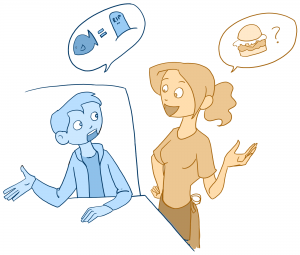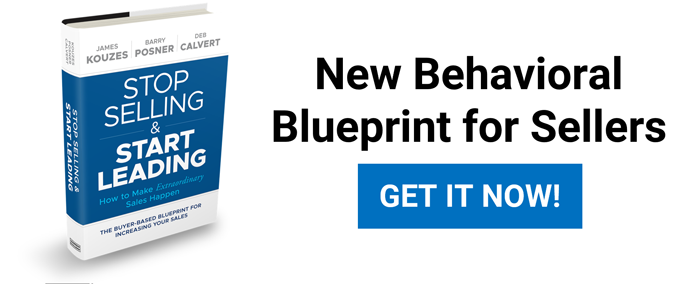5 Sales Tips from a Seafood Server - How About Dessert?
Fisherman’s Wharf, San Francisco. For some reason, tourists think this place is the Northern California equivalent of Disneyland, but I don’t see it. Disneyland has rides, Mickey Mouse and overpriced food. Fisherman’s Wharf has …
Um…
…Sea lions?
One thing that the Wharf has in common with Disneyland, though, is mediocre overpriced food. But whereas Disneyland has an abundance of churros, we’ve got seafood. And depending on your budget, you could go to one of the actually nice restaurants, where the fish is caught fresh daily and the servers wear suits and give you real silverware and cloth napkins.
Or you could go to one of the kitschy, noisy tourist traps like the one I worked at.
Related: The Blueprint for Making Extraordinary Sales
How Switching Sales Tactics Increased Customer Engagement (& Tips)
Working as a server is, in a lot of ways, very similar to working in sales. More often than not, especially in chain restaurants, there will be a certain set of items that servers are strongly encouraged to push. And, especially in the restaurant I worked in, there was a litany of tasks the server had to run down before taking the customers’ order. Bring them silverware. Introduce myself and the accoutrements laid out on the table to them. Start telling them all about the menu and the overwhelming number of things they could order. Suggest certain drinks and food items. And THEN take their order.
And for my first month or so, this ramble at every table was fine, but then I began to notice something.
The glazed look on their faces as I rambled on about the different ways to cook crabs. The bored, hungry expressions as I kept going on about all the different appetizers. The outright impatience as I wasted two minutes of their time talking about the restaurant without actually figuring out what it was they wanted. Understand that, for the majority of these people, they had also just completed the long, unexpected hike from Chinatown, Pier 39, or worse – The Golden Gate Bridge – and were exhausted, cranky and starving. Their children were squirming with hunger and weariness, and to many frazzled customers that summer, I was only irritating them by yakking on about the difference between Dungeness and Snow.
So I tried something else. Instead of starting off by telling them who I was and what I was doing there, I started asking them who they were, how they got to my table, and what they expected out of their experience there. Instead of telling them that the combo appetizer was great and they should get it, I looked for ins and places where I could mention how good it was. And wouldn’t you know it, my promo percentages skyrocketed… as did my tips. I hadn’t ever realized it before, but even though my job title was “server,” sales was definitely a huge part of my job description. Once I embraced these five tricks of the sales trade, my job became easier and my pockets fuller.
5 Highly Effective Sales Tips From a Seafood Server
1. Save the Spiel
 Let’s go back to that opening ramble I had to give all my customers. While it might have been company policy to deliver that spiel and tour the customers around the table, I and most of my coworkers fell into the trap of treating this part as info-vomit. It was something to be spewed out quickly and be gotten over with, something to be checked off a list. Customers clearly hated it, because it was obvious that I was merely spewing out a canned speech that I had been trained to say.
Let’s go back to that opening ramble I had to give all my customers. While it might have been company policy to deliver that spiel and tour the customers around the table, I and most of my coworkers fell into the trap of treating this part as info-vomit. It was something to be spewed out quickly and be gotten over with, something to be checked off a list. Customers clearly hated it, because it was obvious that I was merely spewing out a canned speech that I had been trained to say.
A lot of salespeople do this. Have you ever dreaded going through a line at a retail clothing store, simply because you know you’re going to get the credit card spiel? I dread it. With my huge pile of student loans, I don’t want to tack on more debt with a credit card, much less a shop-specific credit card that I’ll use maybe twice a year. And yet every time I want to buy something even as small as a $7 tank top, it’s the same thing.
“Would you like to open up an account and save 15% on your purchase today?”
Not to pick on retail workers – I know that there is corporate pressure, and often direct managerial pressure, to sell X number of those darn cards. But because it is so frequently delivered with the same falsely-chipper tone of voice and vacant robotic expression, it’s a huge turn-off. There’s no personal investment, no reason why I should open that account and save $1.25 on my stupid tank top.
Nor was there ever any reason for someone who doesn’t like seafood to order the expensive bucket of crabs after listening to me rattle off my pitch.
2. Find Out Who Your Customers are and What They Want

The trick to getting customers to buy the overpriced crustaceans was to ask questions, to make it about their wants and needs, about their time at my table – when I did, they were far more receptive to trying new things.
By winnowing out their desires and needs, I was able to suggest things that I knew they would like. Because people are so inherently “me-centered,” especially when encountering a stranger, it really brings a sense of warmth to a discussion if the selling party seems genuinely invested in the buyer. Not to mention that you can discover what they have and haven’t tried, what they like, and what they might be willing to try.
You don’t need to sell them every promo item. You only need to sell them the item(s) that will best suit their needs and desires. And on the other side of that coin, it comes across as downright irritating, or even offensive, if the seller continues to push something that their customer has expressed disinterest or displeasure in. You can’t sell crabs to someone with a shellfish allergy, and you are definitely going to lose your tip if you continue to try.
Asking questions and learning what your customer’s needs are is so important. Even if it’s simple questions about what they like and dislike, or about new experiences they might want to have, listening and responding to your customer’s needs will always have results that make both of you happy. Whether you’re a highly-skilled sales professional or a server in a touristy seafood restaurant, investing a small amount of time in learning what they actually want, instead of what you think they want (or what you’re told to think they want), will lead to more sales, more tips, and happier customers coming back for more.
3. Follow-Through
 Nothing is worse than sitting at a table for endless minutes waiting for a refill on your beverage, your cold-on-delivery food to be replaced with warm food, and your server to stop chit-chatting with his or her coworkers and attend to your needs. The same can be said true of any salesperson… although for servers it’s much more obvious when they aren’t following through.
Nothing is worse than sitting at a table for endless minutes waiting for a refill on your beverage, your cold-on-delivery food to be replaced with warm food, and your server to stop chit-chatting with his or her coworkers and attend to your needs. The same can be said true of any salesperson… although for servers it’s much more obvious when they aren’t following through.
There’s a restaurant in San Francisco that has a rule against servers saying “is everything all right?” with the presumption that customers hate that question.
True, when it’s interruptive and spoken in that condescending “bless your heart” tone that a lot of servers start adopting, it is obnoxious. But even this simple question, or its equivalents “how are you enjoying your food,” and “is there anything else I can get you,” can make a diner’s experience all the more enjoyable.
Likewise, for professional salespeople, checking back on your customer after their product has been delivered is huge. It might seem obvious, but the mere act of making sure that a customer is satisfied with the product they’ve been delivered goes a long way to ensuring that they return.
Beware, however, that you don’t stop with simply asking if all is well and if they’re satisfied. If the answer is no, then continue to ask and work with your customer to make sure they do get what they need. Don’t leave them hanging – if a server says they’ll get a customer a new plate, condiments, or another drink, they had better deliver, or the customer is left helpless at their table.
Neglected customers are sad customers, and sad customers are customers that won’t tip (or, sometimes, won’t pay) and spread bad word of mouth about you and your workplace. Work tirelessly to see that all their needs are met at all stages of their time with you.
4. Know When to Say Goodbye

Assuming that all had gone well over the course of my customers’ meals – they had a steady stream of iced tea refills to quench their thirst and all condiments and silverware on hand to eat their food – then, once the plates had been cleared and the check printed and tucked away in my apron, it was time to ask the question.
“Who left room for dessert?”
Dessert sales were not very high priority, but they were one of the toughest things to sell. The portions we served were gigantic, easily enough food for two people. So expecting customers to cram another enormous portion of food down their gullets was always a tricky course to maneuver. And often, customers would politely decline, and ask for their bill. (This is why I had it ready to go before I approached them to ask about dessert)
But every so often, I’d get the response “Well, what do you have?”
Again, instead of rattling off all the choices, I would spend a few minutes discussing what they liked. If the promotional dessert matched what they were interested in, I would attempt to sell them that. But if not, if they wanted something else, then that was alright too.
Being pushy generally doesn’t work. The only time that I’ve found it has is if the customer sounds somewhat interested in what it is you’re trying to push. But more often than not, I’ve observed that customers don’t want to be coerced into buying something.
Someone who is full to bursting won’t want a dessert, no matter how enticing you make it sound. And, once again, if you ignore need in favor of a sales pitch, you’ll only end up irritating your customers and reducing their interest in doing further business with you.
5. Be Honest
 All of these things are fine and dandy in a vacuum. But sometimes, your product is going to suck and you’ll have to sell it anyway.
All of these things are fine and dandy in a vacuum. But sometimes, your product is going to suck and you’ll have to sell it anyway.
Trying to sell a terrible product is the worst. For example, we had lobster on the menu at my restaurant. Lobsters, in of themselves, aren’t a bad item. Especially in New England, where they can be caught fresh, lobsters are a delicious indulgence. But lobsters on the West Coast are all shipped from the East Coast, and we never got them fresh. They came in giant boxes, pre-cooked and frozen.
And yet, when customers saw lobster on the menu, they got excited and assumed it was fresh. And when they got their lobsters, more often than not they were disappointed with the way it tasted, or with the fact that they were getting a whole lobster (guts and bright orange caviar and all).
I took to explaining to my customers that the lobsters we got were not fresh, and that they would receive a whole one that they would be expected to crack themselves – that $15 for a whole lobster on the West Coast was definitely a case of getting what you pay for. True, it discouraged people who weren’t certain about ordering lobster, but it made sure that only the people who truly, really wanted to eat a lobster were getting them. And those that weren’t sure ended up getting something else that probably satisfied them more.
By being up front about consistent issues your product might have, customers can have a better idea of what it is they’re getting themselves into. No one likes to be upsold an expensive, seemingly-glamorous product, only to find out that they’re not getting what they expected.
And I’m not saying to take it to the other extreme, either, and intentionally make your product sound bad. But if you sense doubt from your customer, you can save the both of you a lot of trouble by mentioning problems that might arise, and double-check to make sure it’s what your customer really wants. And if they end up wanting something else, that’s great, because they get what they want and don’t feel cheated when the thing you sold them ends up being terrible.
The Moral of the Story:
Listening and responding to your customers is crucial, and is the crux of all these things I learned. And when you listen to and build rapport with that customer, they are more likely to come back for more.


